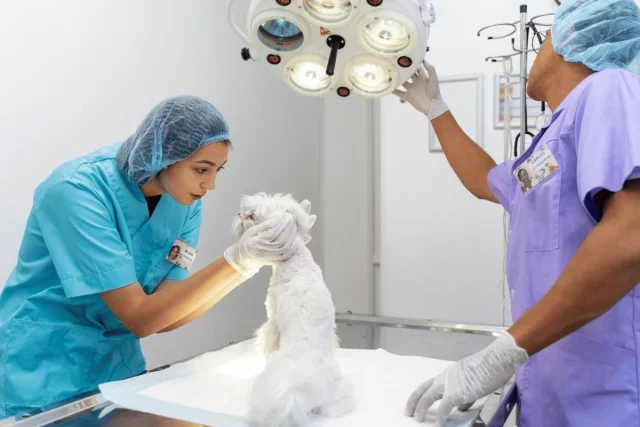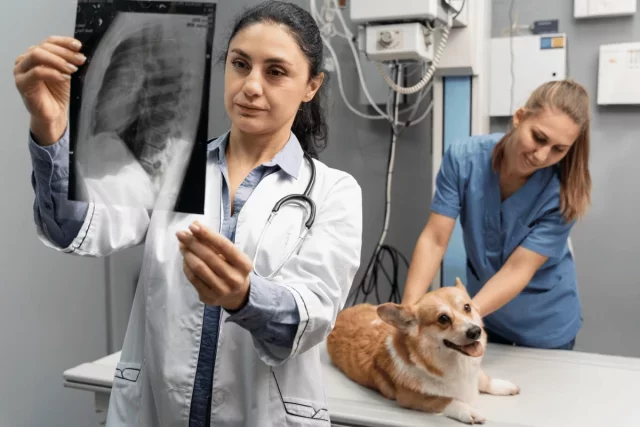Understanding veterinary practice valuation is necessary even if you’re not looking to sell your practice anytime soon. It will help you monitor the health of your business, ensuring that you get to keep doing what you love.
But it’s also a must if you’re thinking of taking out a loan, aiming to enhance your practice’s profitability, or are weighing in on a partner’s interest should they need to make an exit.
This article will break down key concepts in veterinary practice valuation, explain how it works, and let you in on the factors affecting how much a practice is worth.

Finding the guide too long to read at the moment?
Here’s a quick recap of how to conduct the valuation of a veterinary practice:
If you’re looking to sell your veterinary practice, you shouldn’t wait until this last step to enlist the help of a financial advisor.
Exitwise can help you set up a team of M&A experts to maximize the sale of your practice. Here’s how it works.

Determining the value of a veterinary clinic is essential for several reasons:
The valuation report highlights areas for improvement as identified during the valuation. You can act on these areas to maximize the value of the business as part of your exit plan.
You may also share the report with banks and investors if you need credit or funding.
The valuation can be part of your plans to change the ownership of the practice. The change can be through succession, partnership buy-ins, or selling the clinic.
Based on the valuation, you can strengthen the business’s financial position in readiness for when it's time for you to exit.
A detailed vet practice valuation, which involves researching the prevailing veterinary market, lets you compare your practice with its peers based on performance and valuation averages.
Besides identifying areas for improvement, the valuation serves as a reality check to help you stay competitive.
A comprehensive and objective valuation report can help different stakeholders trust you and your business better.
When they notice your professionalism and the practice's strengths, such as high profitability or competitive advantage, they will likely want to support your quest.
If you plan on selling your practice, getting it valued can help you negotiate an ideal sale price.
You can avoid overselling, which scares away potential buyers. Underselling will also be out of the question, ensuring you get your firm's worth.

Figuring out the value of your veterinary practice isn’t as straightforward as calculating income-less expenses.
That’s primarily because it’s not all about the money.
Intangible factors, like reputation and client demographics, significantly impact how much a practice is worth.
Let’s look at 12 factors that you should consider when assessing the value of your veterinary clinic.
It may not be all about the bottom line, but profit does significantly tip the scale when determining a veterinary practice’s value.
You can calculate profitability by subtracting your yearly expenses from your EBITDA. The resulting number is your operating profit, which determines whether you’re running on an appealing profit margin or are barely making it afloat.
The higher your profitability, the healthier your business and the better your chances of an advantageous selling price.
Generally, a veterinary practice is considered profitable when it has net margins of 10 to 25%.
Who your clients are and how loyal they are to you also impact the valuation of your clinic.
Pay attention to client demographics and their income level, as these tell a lot about whether they can afford pet care, how many pets they typically have, and how often they seek veterinary assistance.
Clinics in major cities are often valued more than those in rural areas. Similarly, those in affluent neighborhoods make more than those in lower-income areas.
However, other factors, such as the number of similar practices within the same location, can also impact a practice’s value.
For example, if your clinic is located in an area with many other similar practices, demand for veterinary services is spread across multiple establishments, creating steep competition.

Investing in the latest technology won’t only equip you to provide better care for your patients. It can also boost the value of your veterinary practice.
If you use proprietary technology or equipment that none of the other clinics in your area have, that can make an even greater impact on your clinic’s valuation.
It’s hard to put a number on reputation, but it certainly does impact what a practice is worth.
A clinic or practitioner known for traits like skill, expertise, and compassion is more likely to have a loyal and broader client base than those who aren’t.
That’s because a good reputation breeds trust, and trust brings in more business.
If you want to know what other people think of your practice, social media is a great place to start.
Examine the comments people leave on your page and conversations that mention you in relevant online communities.
The type of services you offer also affects your clinic’s valuation.
Clinics that cater to small animals tend to have a more appealing valuation because the demand for small animal care is greater than for larger animals.
More people prefer to have smaller dog breeds and cats as pets as they’re usually easier to maintain and care for.
Moreover, offering highly specialized services, like animal surgery, also impacts a clinic’s value.
A team of well-qualified and experienced veterinarians and assistants and your team's size affect your practice's value.
For instance, being the only veterinarian on board is less appealing than having several highly skilled vets on your staff. Your qualifications and expertise will also weigh more heavily on the valuation.

How efficiently do you run your practice? Do you have a solid inventory management system in place? How do your books look?
All of these tell about the quality of your veterinary services and impact your practice’s profitability and potential for growth.
If your books look messy, consider hiring a CPA to get them in order as soon as possible.
Not only will it make generating profit statements easier, but it will also help you negotiate for a better sale price should you consider selling your practice.
The level of competition in your area will affect the value of your practice.
Veterinary clinics competing with several other practices in the same location tend to have a lower value.
That’s because their client base is typically smaller, and the expansion opportunities are much less.
Like any medical practice, veterinary clinics are subject to state and federal laws.
Failure to comply with any legal requirements affects one’s credibility, which naturally results in a drop in a practice’s value.
Among the licenses that a veterinary clinic must have are the following:
A practice with a promising outlook for expansion and growth tends to be worth more.
Drivers of growth include technology, specialization, and staff expertise. Assessors typically look at these when determining a practice’s potential to scale, as should you.
Regardless of whether you want to sell, you can invest in these areas to stay competitive.
The economy may be entirely out of your control, but it’s, unfortunately, a major driving force that impacts how much your practice is worth.
For instance, selling your practice in the middle of a recession will cause your clinic’s value to plummet. In such a case, your client base will naturally shrink, as people will prioritize necessities rather than pet care.
Trends, such as the preference for smaller pets, also impact valuation. The more in-demand your services are, the higher their worth.

We’ve discussed the factors impacting how much a veterinary practice sells for. Now, let’s look at the methods used in valuing a practice.
The Income Approach is the most commonly used method in determining the value of a veterinary practice. It looks at a clinic’s cash flow (income and expenses) to determine its profitability.
When using this approach, you’ll need to determine your operating profit, which is your EBITDA (earnings before interest, taxes, depreciation, and amortization) minus your yearly expenses.
Because it’s so straightforward and effective at providing insight into the actual profitability of a practice, this approach is helpful whether you’re looking to sell or simply want to gauge how healthy your business is.
It’s also advantageous for those confident that their profit and loss statements will invite promising buyer contracts.
The second most common method is the Market Approach, which entails comparing your practice against similar outfits in your area to arrive at an estimated value.
Unlike the Income Approach, however, this method is less accurate, as you will rely on data from other publicly-held establishments.
Since most clinics are private entities, obtaining accurate information is hard. And even when you have data available, you’ll be looking mainly at collections, which are only half the picture.
Still, this approach may be helpful for those who need to justify the value of their practice in a legal or partner dispute.
The Asset-Based Approach involves gauging the value of a practice based on its tangible and intangible assets.
Any liabilities are deducted from the fair value of these assets to arrive at the Net Asset Value (NAV).
Intangible assets, also called goodwill, may not have a direct dollar value but are factored in to arrive at an accurate picture of how much a practice is actually worth.
Intangible assets include a practice’s reputation, the quality of its client base, and the expertise of its staff.
You may use this approach to look beyond revenue and consider your practice’s potential for growth. It’s also advantageous when your assets (especially your intangible assets) are your biggest drivers of profitability.

Some people refer to certain “rules of thumb” when valuing a veterinary practice.
The most common of these are:
However, these have long been debunked as credible methods for determining a practice’s actual value due to one main reason: no two practices are exactly alike.
It’s impossible to accurately value a practice without considering nuances that make it unique.
The Discounted Cash Flow Analysis is a valuation method that looks at cash flow history to predict future trends in revenue.
It provides insights on whether investing in or buying a practice is worthwhile by determining its capacity to maintain or increase its profitability in the future.
You can use this model to show the potential of your practice to be profitable, such as when pitching to a potential buyer.
As its name suggests, the Comparable Sales Method is commonly used to indicate the value of a practice by looking at the sales of similar establishments within a specific location.
The end value is intended as a ballpark estimate and may not account for unique characteristics that differentiate one practice from another.
Note that even practices with similar attributes will have differing qualities. Also, this method is best suited only when recent sales of comparable establishments exist.

When you want to determine the share price of your practice, the Earnings Multiplier Method (also known as the Price-to-Earnings Ratio Method) is your best option.
It calculates potential returns and determines a practice's share price compared to similar ventures.
This method is beneficial when you’re out to find investors or need to gauge the financial health of your practice.
Also known as the Modified Book Value Approach, this method entails deducting the value of a practice’s tangible and intangible assets from its liabilities to arrive at a fair market value.
This approach is typically used when a practice is facing financial distress or when a potential buyer may not expect to gain commercial goodwill from the sale.
The Capitalization of Earnings Approach focuses on anticipated profits based on a practice’s earnings history.
It’s most beneficial when valuing well-established clinics with a predictable or stable cash flow, as they are better equipped to generate reliable projections.
This method is also beneficial for gaining a more balanced picture of the financial stability of a practice since it discloses both future performance and potential risks.

While you may not be well-versed in all these valuation methods, preparing your practice well can ensure a favorable valuation.
You should consider the aspects below:

Ready to assess how much your practice is worth? Here are 6 steps you’ll need to take:
As mentioned earlier, EBITDA stands for earnings before interest, taxes, depreciation, and amortization. This is essential for gaining a clear picture of your practice’s profitability.
To calculate EBITDA, use either of these formulas:
Option 1: EBITDA = Net Income + Interest + Taxes + Depreciation + Amortization
Option 2: EBITDA = Operating Profit + Depreciation +Amortization
But you can further simplify the process using this valuation calculator.
Now, factor in your tangible and intangible assets.
Your tangible assets are easier to translate into a dollar value. These are your facilities, equipment, furniture, supplies inventory, etc.
But intangible assets are also an essential part of the total value of your practice.
In a nutshell, your intangible assets are your professional and commercial goodwill, which involves your reputation, online presence, and staff experience and expertise.
When choosing the valuation method to use, take into consideration the following factors:
The Income Approach is best suited if you want a straightforward valuation process that relies heavily on your profit and loss statements.
On the other hand, the Asset-Based Approach is designed to cater to practices whose intangible assets significantly impact their market value.

It can be helpful to look at how similar practices in your area are worth to determine whether your practice is given fair market value.
To do this, consider properties with similar attributes, study their client base and cash flows, and research industry trends that impact your practice.
There may be some unaccounted factors even when you use the valuation method best suited for your practice.
These are things like shifts in the economy, the loyalty of your client base, its growth potential, and changes in the industry.
These external factors are typically out of your control but significantly impact how much your practice is worth.
Once all relevant factors have been considered, you may now finalize the valuation. It’s time to put it all on paper.
This entails writing a valuation report that involves all relevant data supporting the valuation process and its conclusion.
Verify all information and review your report to ensure you have maximized every opportunity to negotiate the highest possible deal.
If you’re valuing your practice as part of an exit, having exit strategy experts on board will make the process easier.
Get in touch with Exitwise advisors to build your team of M&A experts.

You'll want to bring in valuation experts 3-5 years before the planned time of exit. If you can't fulfill this, hiring the experts at least one year before the exit time can work.
You can also look at the ‘when’ aspect in terms of situations rather than specific dates.
Valuation professionals are essential in circumstances such as ownership transfer, legal disputes, strategic planning, and seeking funding or credit facilities.
Regarding the ‘why’ aspect, here’s why hiring experts is important:

Here are the most commonly asked questions on veterinary practice valuation, answered!
The typical profit margin for a veterinary practice is 10 to 25%. The more specialized the practice, the higher the profit margins usually are.
Other factors driving profitability include the clinic's reputation, availability of emergency care, and staff size.
A veterinary practice that uses state-of-the-art or proprietary technology is valued much higher than those that don’t.
Valuation also considers the condition of facilities–how well-maintained they are, how efficiently the clinic operates, and where the clinic is located.
Reputation is a significant factor affecting a practice’s intangible assets or goodwill.
A clinic or a doctor associated with quality service, compassion, and skill naturally draws more clients and has a greater growth potential.
If you aren't planning to sell your veterinary practice soon, you can have it valued every 3-5 years.
Valuations at this pace help you track the business’s progress over time so you can stay focused on what drives growth, identify improvement areas, better understand financial health, and prepare well for future transitions.
Valuing a veterinary practice isn’t as cut-and-dried as most of us wish it would be.
It involves looking at internal and external factors that drive profitability and adjusting for intangible assets that are challenging to translate into a dollar value.
So, just as you’re the expert on animal care and your clients come to you for the well-being of their pets, you need financial experts to take the load of valuing your practice off your shoulders.
Chat with Exitwise advisors today to build your team of M&A experts!
Let Exitwise introduce, hire and manage the best, industry specialized, investment bankers, M&A attorneys, tax accountants and other M&A advisors to help you maximize the sale of your business.

